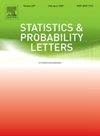许多设计列的嵌套近正交拉丁超立方体设计
IF 0.7
4区 数学
Q3 STATISTICS & PROBABILITY
引用次数: 0
摘要
嵌套拉丁超立方体设计被广泛用于进行具有不同保真度的多个计算机实验。在多项式函数模型的背景下,实现正交性尤为重要,因为它可以在一阶模型下对线性效应进行不相关估计。因此,在设计施工中,保持低的因素间相关性是一个非常理想的特性。本文提出了一种构造具有柔性设计列和低因子间相关性的嵌套近正交拉丁超立方体设计的新方法。与现有嵌套拉丁超立方体设计的对比研究表明,所提出的设计实现了更低的因子间相关性,所需的运行次数更少,使其在实际应用中更高效、更具成本效益。本文章由计算机程序翻译,如有差异,请以英文原文为准。
Nested nearly orthogonal Latin hypercube designs for many design columns
Nested Latin hypercube designs are widely employed for conducting multiple computer experiments with varying levels of fidelity. In the context of polynomial function models, achieving orthogonality is particularly important, as it enables uncorrelated estimation of linear effects under a first-order model. Therefore, maintaining low inter-factor correlation is a highly desirable property in design construction. In this paper, we propose a novel method for constructing nested nearly orthogonal Latin hypercube designs with flexible design columns and low inter-factor correlations. Comparative studies with existing nested Latin hypercube designs demonstrate that the proposed designs achieve lower inter-factor correlations and require fewer runs, making them more efficient and cost-effective for practical applications.
求助全文
通过发布文献求助,成功后即可免费获取论文全文。
去求助
来源期刊

Statistics & Probability Letters
数学-统计学与概率论
CiteScore
1.60
自引率
0.00%
发文量
173
审稿时长
6 months
期刊介绍:
Statistics & Probability Letters adopts a novel and highly innovative approach to the publication of research findings in statistics and probability. It features concise articles, rapid publication and broad coverage of the statistics and probability literature.
Statistics & Probability Letters is a refereed journal. Articles will be limited to six journal pages (13 double-space typed pages) including references and figures. Apart from the six-page limitation, originality, quality and clarity will be the criteria for choosing the material to be published in Statistics & Probability Letters. Every attempt will be made to provide the first review of a submitted manuscript within three months of submission.
The proliferation of literature and long publication delays have made it difficult for researchers and practitioners to keep up with new developments outside of, or even within, their specialization. The aim of Statistics & Probability Letters is to help to alleviate this problem. Concise communications (letters) allow readers to quickly and easily digest large amounts of material and to stay up-to-date with developments in all areas of statistics and probability.
The mainstream of Letters will focus on new statistical methods, theoretical results, and innovative applications of statistics and probability to other scientific disciplines. Key results and central ideas must be presented in a clear and concise manner. These results may be part of a larger study that the author will submit at a later time as a full length paper to SPL or to another journal. Theory and methodology may be published with proofs omitted, or only sketched, but only if sufficient support material is provided so that the findings can be verified. Empirical and computational results that are of significant value will be published.
 求助内容:
求助内容: 应助结果提醒方式:
应助结果提醒方式:


